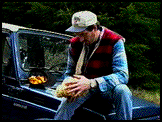Oregon Mushrooms



From left to right: Cantharellus formosus button; a basket of Boletus edulis; some Tricholoma magnivelare, and Boletus mirabilis in the dryer. Below: my friend Robin Marcum of Lyons, Oregon holding a Sparassis crispa.
mirabilis in the dryer. Below: my friend Robin Marcum of Lyons, Oregon holding a Sparassis crispa.
To get an idea of the roles that fungi play in the forest and a base to begin comprehension of the discussion, visit the Forest Food Cycle page.
For more information about Oregon Truffles, visit TruffleZone.com.
Click here for more information about chanterelle mushrooms.
Fungal Taxonomy
As I learn more about the fungi that I have been collecting for a couple of decades, I am finding that the information that I have come to accept as fact is indeed a changing information base. The names of our Northwest mushrooms have been taken from mostly European species. With the advent of the electron microscope and an increased need for scientists to study local fungi for a number of reasons, I have been finding that our local fungi are not what are represented in most taxonomic keys. I will elaborate more on this as I continue to revise my pages.
The 1998 Mushroom Crop Report for Oregon
1998 has been a less than bountiful year for collection of fungal fruiting bodies. The morels failed to fruit in any numbers here in the Willamette Valley (I collected 3 pounds in April). It cost me more in shoe leather than the return that I received from the mushrooms. The spring morel and Boletus edulis fruitings east of the Cascade Summit were fair but the mushrooms were wormy. This was probably due to large insect populations after the mild winter we had last year. I was unable to collect more than a gallon of usable mushrooms of any species on any foray.
August 1998
Very little rain in July and August meant: No lobster mushrooms; Very few early chanterelles; and very hungry collectors. What matsutakes?
September 1998
Still no rain. Still no mushrooms. I collected 4 lobster mushrooms and about a dozen chanterelles.
October 1998
The drizzles started late. The areas where I normally collect chanterelles in the Coast Range were very dry and there were NO mushrooms. There were no permits issued for the areas that were fruiting in the Coast Range (more on this later). The Cascades were producing fairly good amounts of chanterelles in areas where the August thunder showers provided enough moisture to start the mushrooms growing but these areas were not numerous. This concentrated the pickers (once they realized that the mushrooms were coming off somewhere) and made finding chanterelles more difficult than usual. The matsutakes were very sparse in Central Oregon with prices at $50 per pound for number ones and two in Crescent Junction for part of the month. I haven't heard how the last two weeks of the matsutake season went over there.
November 1998
So far, this November has been very disappointing. The truffles have yet to ripen and have not even appeared in some of the best patches. On the west slope of the Cascades, the chanterelles did not continue to fruit after the first picking in many places. The snows have now effectively stopped collection in the higher patches that were fruiting well a bit earlier and the lower eleveation patches are not offering many returns. The chanterelles really didn't appear in the higher areas of the Coast Range and the lower areas that I visited yesterday (Nov. 6) were not fruiting at all.
Former Foray Reports (from 1995 through 1997- with great graphics of various
mushrooms.
NOW!!!! AT LAST!! REX TELLS ALL!!!!!!!
How to find mushrooms and truffles!!!!
These Webpages are mirrored on different sites around the Web.
For the most recent update of these pages, go to
https://members.tripod.com/~rexs13/
.
This page was updated on November 2, 1998.
Click here to get truffle and other mushroom ordering information.
Click here to go back to index
Click here to see some truffles.








 mirabilis in the dryer. Below: my friend Robin Marcum of Lyons, Oregon holding a Sparassis crispa.
mirabilis in the dryer. Below: my friend Robin Marcum of Lyons, Oregon holding a Sparassis crispa.